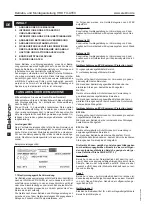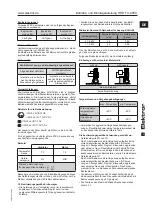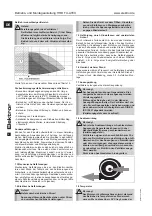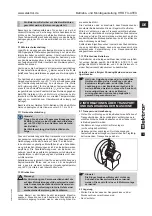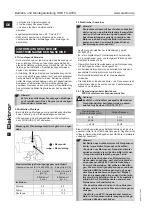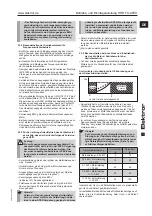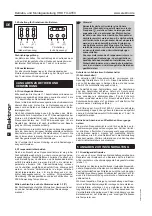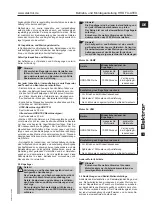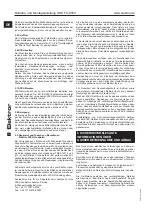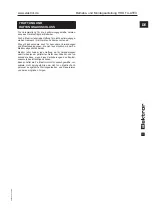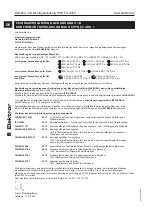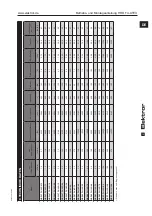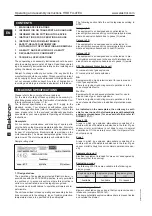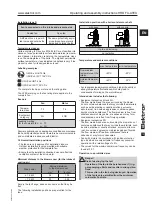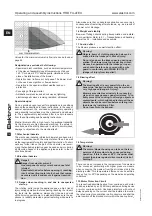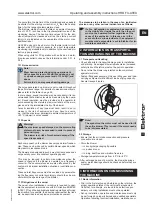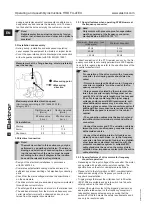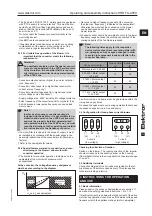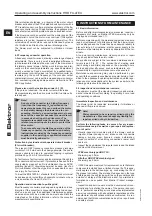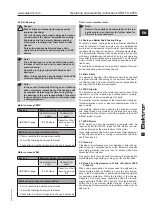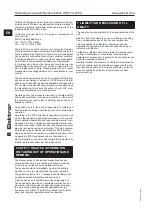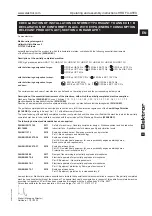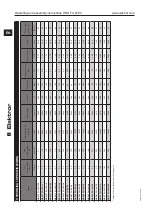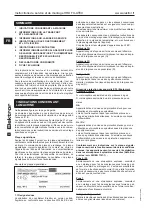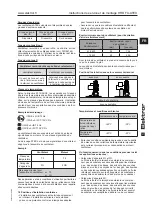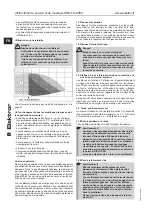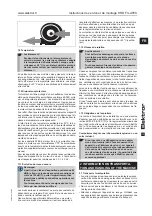
14
EN
Operating and assembly instructions HRD FU-ATEX
www.elektror.com
9016330 01.20/08
CONTENTS
1 MACHINE SPECIFICATIONS
2 INFORMATION ON TRANSPORT AND HANDLING
3 INFORMATION ON PUTTING INTO SERVICE
4 INSTRUCTIONS FOR OPERATION AND USE
5 INSTRUCTIONS FOR MAINTENANCE
6 SAFETY-RELATED
INFORMATION
ON TAKING OUT OF OPERATION AND REMOVAL
7 LIABILITY AND EXCLUSION OF LIABILITY
8 DECLARATION OF CONFORMITY
9 TECHNICAL SPECIFICATIONS
These operating and assembly instructions should be avail-
able to operating personnel at all times. Read these operat-
ing and assembly instructions carefully before installing and
putting the blower into service.
Subject to change without prior notice. If in any doubt, the
manufacturer should be consulted. This document is protect-
ed by copyright. It must not be disclosed to third parties with-
out our express written consent. Any form of duplication or
recording and storage in electronic equipment is forbidden.
1 MACHINE SPECIFICATIONS
Please refer to the cover sheet for our address.
For the area of validity of these operating and assembly in-
structions, please refer to the Declaration of Installation Con-
formity contained in Annex II 1 B.
The technical speci
fi
cations on page 24
ff
. apply to the
standard version. Your blower’s speci
fi
cations may di
ff
er
from these speci
fi
cations (refer to nameplate). If this is the
case, please refer to the enclosed, additionally applicable
documents or your own applicable Operating and Assembly
Instructions.
Nameplate
For connection, maintenance and ordering of spare parts,
only the data on the blower nameplate is de
fi
nitive. Also refer
to the nameplate for the serial number of the appliance and
its year of manufacture. Electrical data is provided on the
motor nameplate. The blower nameplate applies to the com-
plete blower. The motor nameplate is subordinate to this.
Sample rating plate:
1.1 Designated use
The operation of an explosion-protected Elektror blower, in
accordance with the 2014/34/EC directive, is only permitted
in countries or in economic sectors where this directive is
valid or is not restricted, as well as legally recognised.
Conversion and modi
fi
cations to operational blowers are im-
permissible.
The units described in these operating and assembly instruc-
tions correspond to the category, type of ignition protection,
temperature class, etc. speci
fi
ed on the nameplate.
The following section lists the unit categories according to
ATEX:
Category 3G
The equipment is so designed and constructed as to
prevent ignition sources during normal operation in areas
where an explosion hazard due to gases (G) exists.
Category 3D
The equipment is so designed and constructed as to
prevent ignition sources during normal operation in areas
where an explosion hazard due to dust (D) exists.
Category 2G
The equipment is so designed and constructed as to pre-
vent ignition sources even in the event of disturbances in
areas where an explosion hazard due to gases (G) exists.
EPL (Equipment Protection Level)
G
area at risk of gas explosions
D
area at risk of dust explosions
Gb:
Equipment with a high protection level for use in areas at
risk of gas explosions.
There is no ignition risk during normal operation or in the
case of expected faults.
Gc / Dc:
Equipment with an enhanced protection level for use in
areas at risk of gas / dust explosions.
There is no ignition risk during normal operation or in the
case of expected faults due to additional protective meas-
ures.
As indicated on the nameplates, the units may be suit-
able for use in one of the following areas with potentially
explosive atmospheres (for an exact de
fi
nition refer to:
DIN EN 1127-1):
Zone 2 / 22
Areas in which an explosive atmosphere consisting of a
mixture with air of
fl
ammable substances in the form of gas,
vapour, mist or air mixtures is not likely to occur in normal
operation but, If it does rarely occur, then it will persist for a
short period only.
Zone 1
Areas in which an explosive atmosphere consisting of a
mixture with air of
fl
ammable substances in the form of gas,
vapour or mist is likely to occur in normal operation occasion-
ally.
Equipment group II
Electrical equipment intended for areas not endangered by
fi
redamp (other than mining).
Explosion groups
The following ATEX fans are available in the following ex-
plosion groups:
Explosion group
IIB
Explosion group
IIIC
Explosion group
IIC
Available
Available
On request
Installation type B or C
Blower connected on one end only, that is on pressure end or
intake end (compare DIN 24163).
The same potentially explosive atmosphere is present inside
and outside the blower.


